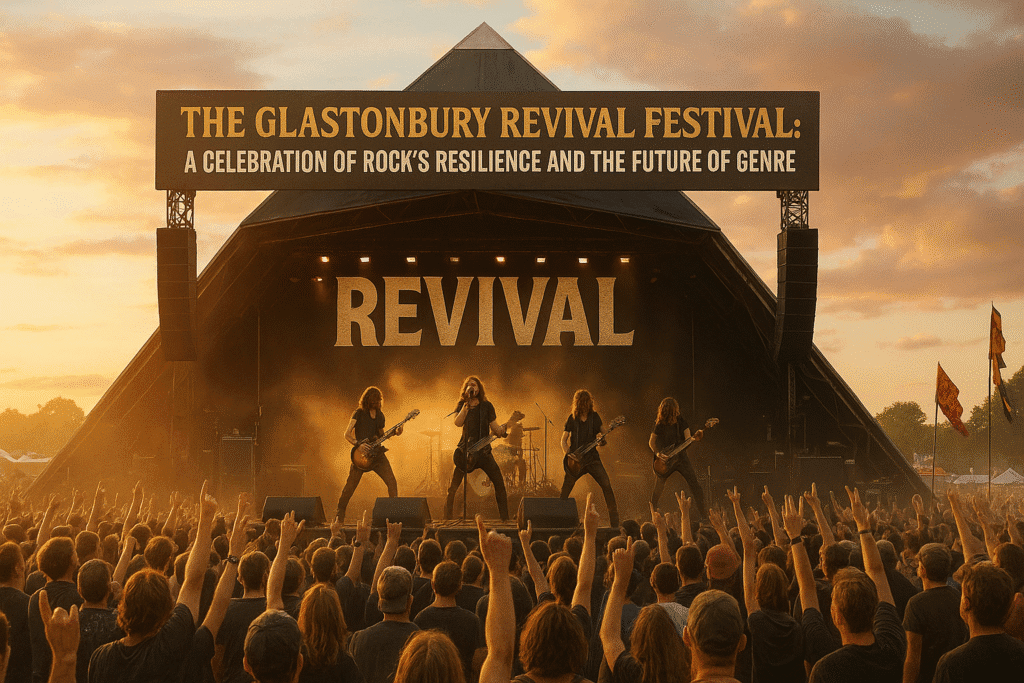The Glastonbury Revival Festival, held on October 26, 2024, was an electrifying event that not only celebrated the rich history of rock music but also showcased the genre’s exciting future. Held at the iconic Glastonbury festival grounds, this one-day event gathered both legendary rock acts and promising emerging bands, all united in their love for the genre. Amid a music industry increasingly dominated by pop and hip-hop, the Glastonbury Revival Festival was a powerful reminder of rock’s enduring influence and its capacity to evolve with the times.
A Thrilling Performance by The Rolling Stones
The festival’s headliner, The Rolling Stones, provided a masterclass in rock ‘n’ roll. Despite being in the twilight of their illustrious career, Mick Jagger, Keith Richards, Charlie Watts, and Ronnie Wood proved that their legendary status is well-earned. The setlist was a tribute to the band’s historic contributions to rock, with classic tracks like “Paint It Black,” “Start Me Up,” and “Sympathy for the Devil” electrifying the crowd. Each song was delivered with the energy and passion that has kept the Stones at the top of their game for decades.
However, it was the surprise collaboration between The Rolling Stones and the alternative rock band Wolf Alice that became the festival’s defining moment. The two groups teamed up to perform “Gimme Shelter,” one of the Stones’ most iconic tracks. The fusion of the Stones’ timeless sound with Wolf Alice’s modern, gritty energy created an unforgettable performance that had the audience in a frenzy. The collaboration was not just a highlight of the evening, but a symbolic representation of rock’s ability to bridge the past and the future.
The Future of Rock: Emerging Bands Shine Bright
While The Rolling Stones’ performance stole much of the spotlight, the festival also provided a platform for emerging rock bands to demonstrate their talent and potential. Groups like The Intergalactic Wolves and Thunderstrike were among the standout performers, showcasing a fresh approach to rock music. These up-and-coming bands blend classic rock influences with contemporary sounds, pushing the genre forward while respecting its roots.
The Intergalactic Wolves, known for their spacey, experimental sound and powerful stage presence, brought a new twist to the traditional rock setup. Their set was a sonic exploration that mixed elements of garage rock, psychedelia, and electronic music, making them one of the most talked-about bands of the festival. Their performance not only captivated the crowd but also established them as a band to watch in the coming years.
Thunderstrike, another rising act, offered a more straightforward rock sound, but with a modern twist. Their energetic, high-octane performance, filled with heavy guitar riffs and anthemic choruses, resonated with fans of classic rock while attracting younger listeners. With their raw, unpolished energy and ability to capture the spirit of rock ‘n’ roll, Thunderstrike has quickly become one of the most exciting new bands on the scene.
A New Era for Rock Music
The success of the Glastonbury Revival Festival was a powerful statement about the continued relevance of rock music in the modern era. While it is true that pop and hip-hop dominate the charts, the festival highlighted that rock still has a vital place in the music landscape. The fusion of classic rock legends with emerging talent was a testament to rock’s adaptability, as it continues to evolve by embracing new influences and sounds.
The Glastonbury Revival Festival also demonstrated the power of live music in maintaining rock’s cultural significance. While streaming and digital platforms are essential for the industry, there’s something about the communal experience of a live rock show that connects fans to the music in a way that other genres struggle to replicate. The festival’s success proved that rock music can still pack stadiums and inspire new generations of fans, even in the age of social media and streaming.
The Legacy of the Rolling Stones
For The Rolling Stones, the Glastonbury Revival Festival was another opportunity to reinforce their legendary status. Despite being one of the oldest and most influential bands in rock history, they showed that they still have the ability to deliver unforgettable performances. Their set at the festival not only reminded fans of their unparalleled contributions to rock but also solidified their legacy as icons of the genre.
The collaboration with Wolf Alice demonstrated that The Rolling Stones are not content to rest on their laurels. Instead, they remain actively engaged with the current musical landscape, using their platform to support and elevate newer artists. The performance of “Gimme Shelter” with Wolf Alice was a fitting metaphor for the way the Stones continue to pass the torch, sharing their space with the next generation while maintaining their own rock ‘n’ roll swagger.
A Lasting Impact on Rock’s Future
The Glastonbury Revival Festival was not just a celebration of rock music’s past—it was a celebration of its future. With emerging bands like Thunderstrike and The Intergalactic Wolves leading the charge, rock is poised for a renaissance that blends the best of both worlds. By incorporating new sounds and ideas while honoring the genre’s foundations, these young acts are ensuring that rock music remains relevant for years to come.
As the festival came to a close, it was clear that the Glastonbury Revival had reinvigorated the rock scene. With legendary performances from The Rolling Stones and the introduction of exciting new talent, the event proved that rock is far from dead. Instead, it is thriving, evolving, and embracing the future while honoring its rich history. The Glastonbury Revival Festival will undoubtedly go down in history as a pivotal moment in the ongoing evolution of rock music, breathing new life into the genre and ensuring its continued relevance in the ever-changing world of music.


